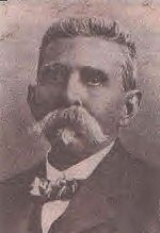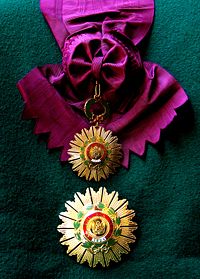
Fermín Tangüis
Encyclopedia
Fermín Tangüis was a Puerto Rican
businessman, agriculturist and scientist
who developed the seed that would eventually produce the Tanguis cotton in Peru
and save that nation's cotton industry.
to San Juan, Puerto Rico
where he met and married a young Puerto Rican girl by the name of Justa Uncal. Tangüis was born in San Juan, the capital of Puerto Rico, and there he received his primary and secondary education. Tangüis moved to Cuba
to pursue a university degree; however when the Ten Years' War
(1868–1878) broke out in that island, he decided that it would be best to move to South America
.
He moved to Lima
, Peru
in 1873, when he was 22 years old and worked as a mercantile accountant. Tangüis went on to work in the mines of Castrovirreyna and later established his own businesses in Ayacucho
and in Huancavelica. In July 1884, he married Isabel Novoa and in 1890, at the age of 39, he purchased land in Valle de Pisco and established a plantation dedicated to cultivation of cotton.
with the seeds of various cotton plants. In 1911, after 10 years of experimenting and failures, Tangüis was able to develop a seed which produced a superior cotton plant resistant to the disease. The seeds produced a plant that had a 40% longer (between 29 mm and 33 mm) and thicker fiber that did not break easily and required little water. The cotton grown in Peru (Egyptian cotton) before the fungus plague grew only once a year; the Tangüis cotton grows six times a year. This type of fiber showed a better resistance and performance than other fibers.
 Tangüis shared his new seeds with the other cotton growers, who named the plant which the seeds produced Tangüis Cotton. Tangüis cotton grows in Canete’s valley (south of Lima) and in the Central Coast of Peru. The success of the Tangüis cotton, which is also known in Peru as "Oro Blanco" (White Gold), saved the cotton industry of that nation. In 1918, Peru began to export the Tangüis cotton variety, which together with the exportation of sugar, made it possible for the government of Peru to cover its national budget. It is highly regarded world wide and is listed on the Cotton Exchange
Tangüis shared his new seeds with the other cotton growers, who named the plant which the seeds produced Tangüis Cotton. Tangüis cotton grows in Canete’s valley (south of Lima) and in the Central Coast of Peru. The success of the Tangüis cotton, which is also known in Peru as "Oro Blanco" (White Gold), saved the cotton industry of that nation. In 1918, Peru began to export the Tangüis cotton variety, which together with the exportation of sugar, made it possible for the government of Peru to cover its national budget. It is highly regarded world wide and is listed on the Cotton Exchange
of Liverpool
in the United Kingdom
. In 1997, the Tanguis cotton, the variety which is preferred by the Peruvian national textile industry, constituted 75 percent of all the Peruvian cotton production, both for domestic use and apparel exports. The Tanguis cotton crop was estimated at 225,000 bales that year.
 The President of Peru Augusto B. Leguia
The President of Peru Augusto B. Leguia
(1919 to 1930), honored Tangüis by presenting him with the "Orden del Sol" (Order of the Sun) medal. The Orden del Sol is a decoration which the Government of Peru presents to its citizens and foreigners for their extraordinary accomplishments in the fields of the arts, literature, culture and politics.
Tangüis became a wealthy man and continued to tend to his plantation the remainder of his life. Fermín Tangüis died on August 24, 1930 and is buried in the Maestro Presbitero Cemetery in Lima.
Puerto Rican people
A Puerto Rican is a person who was born in Puerto Rico.Puerto Ricans born and raised in the continental United States are also sometimes referred to as Puerto Ricans, although they were not born in Puerto Rico...
businessman, agriculturist and scientist
Scientist
A scientist in a broad sense is one engaging in a systematic activity to acquire knowledge. In a more restricted sense, a scientist is an individual who uses the scientific method. The person may be an expert in one or more areas of science. This article focuses on the more restricted use of the word...
who developed the seed that would eventually produce the Tanguis cotton in Peru
Peru
Peru , officially the Republic of Peru , is a country in western South America. It is bordered on the north by Ecuador and Colombia, on the east by Brazil, on the southeast by Bolivia, on the south by Chile, and on the west by the Pacific Ocean....
and save that nation's cotton industry.
Early years
Tangüis' father, Enrique Tangüis, emigrated from FranceFrance
The French Republic , The French Republic , The French Republic , (commonly known as France , is a unitary semi-presidential republic in Western Europe with several overseas territories and islands located on other continents and in the Indian, Pacific, and Atlantic oceans. Metropolitan France...
to San Juan, Puerto Rico
San Juan, Puerto Rico
San Juan , officially Municipio de la Ciudad Capital San Juan Bautista , is the capital and most populous municipality in Puerto Rico, an unincorporated territory of the United States. As of the 2010 census, it had a population of 395,326 making it the 46th-largest city under the jurisdiction of...
where he met and married a young Puerto Rican girl by the name of Justa Uncal. Tangüis was born in San Juan, the capital of Puerto Rico, and there he received his primary and secondary education. Tangüis moved to Cuba
Cuba
The Republic of Cuba is an island nation in the Caribbean. The nation of Cuba consists of the main island of Cuba, the Isla de la Juventud, and several archipelagos. Havana is the largest city in Cuba and the country's capital. Santiago de Cuba is the second largest city...
to pursue a university degree; however when the Ten Years' War
Ten Years' War
The Ten Years' War , also known as the Great War and the War of '68, began on October 10, 1868 when sugar mill owner Carlos Manuel de Céspedes and his followers proclaimed Cuba's independence from Spain...
(1868–1878) broke out in that island, he decided that it would be best to move to South America
South America
South America is a continent situated in the Western Hemisphere, mostly in the Southern Hemisphere, with a relatively small portion in the Northern Hemisphere. The continent is also considered a subcontinent of the Americas. It is bordered on the west by the Pacific Ocean and on the north and east...
.
He moved to Lima
Lima
Lima is the capital and the largest city of Peru. It is located in the valleys of the Chillón, Rímac and Lurín rivers, in the central part of the country, on a desert coast overlooking the Pacific Ocean. Together with the seaport of Callao, it forms a contiguous urban area known as the Lima...
, Peru
Peru
Peru , officially the Republic of Peru , is a country in western South America. It is bordered on the north by Ecuador and Colombia, on the east by Brazil, on the southeast by Bolivia, on the south by Chile, and on the west by the Pacific Ocean....
in 1873, when he was 22 years old and worked as a mercantile accountant. Tangüis went on to work in the mines of Castrovirreyna and later established his own businesses in Ayacucho
Ayacucho
Ayacucho is the capital city of Huamanga Province, Ayacucho Region, Peru.Ayacucho is famous for its 33 churches, which represent one for each year of Jesus's life. Ayacucho has large religious celebrations, especially during the Holy Week of Easter...
and in Huancavelica. In July 1884, he married Isabel Novoa and in 1890, at the age of 39, he purchased land in Valle de Pisco and established a plantation dedicated to cultivation of cotton.
Cotton and its significance in Peru's economy
Sugar and cotton were the two most important agricultural products of Peru in the 19th century. In 1901, Peru's cotton industry suffered because of a fungus plague caused by a plant disease known some places as "cotton wilt" and in others as "Fusarium wilt" (Fusarium vasinfectum). The plant disease, which spread throughout Peru, enters the plant by its roots and works its way up the stem until the plant is completely dried up. Many of the agriculturists who dedicated themselves to the cultivation of cotton were ruined and the cotton industry in general was in crisis.Tangüis cotton
Tangüis began to study some species of the plant that were affected by the disease to a lesser extent and experimented in germinationGermination
Germination is the process in which a plant or fungus emerges from a seed or spore, respectively, and begins growth. The most common example of germination is the sprouting of a seedling from a seed of an angiosperm or gymnosperm. However the growth of a sporeling from a spore, for example the...
with the seeds of various cotton plants. In 1911, after 10 years of experimenting and failures, Tangüis was able to develop a seed which produced a superior cotton plant resistant to the disease. The seeds produced a plant that had a 40% longer (between 29 mm and 33 mm) and thicker fiber that did not break easily and required little water. The cotton grown in Peru (Egyptian cotton) before the fungus plague grew only once a year; the Tangüis cotton grows six times a year. This type of fiber showed a better resistance and performance than other fibers.

Cotton Exchange
The Cotton Exchange may refer to:*Bremen Cotton Exchange *Houston Cotton Exchange*Karachi Cotton Exchange*Liverpool Cotton Exchange*New Orleans Cotton Exchange*New York Cotton Exchange*Mobile Cotton Exchange*Memphis Cotton Exchange...
of Liverpool
Liverpool
Liverpool is a city and metropolitan borough of Merseyside, England, along the eastern side of the Mersey Estuary. It was founded as a borough in 1207 and was granted city status in 1880...
in the United Kingdom
United Kingdom
The United Kingdom of Great Britain and Northern IrelandIn the United Kingdom and Dependencies, other languages have been officially recognised as legitimate autochthonous languages under the European Charter for Regional or Minority Languages...
. In 1997, the Tanguis cotton, the variety which is preferred by the Peruvian national textile industry, constituted 75 percent of all the Peruvian cotton production, both for domestic use and apparel exports. The Tanguis cotton crop was estimated at 225,000 bales that year.
Later years

Augusto B. Leguía
Augusto Bernardino Leguía y Salcedo was a Peruvian politician who twice occupied the Presidency of Peru, from 1908 to 1912 and from 1919 to 1930.-Early life:...
(1919 to 1930), honored Tangüis by presenting him with the "Orden del Sol" (Order of the Sun) medal. The Orden del Sol is a decoration which the Government of Peru presents to its citizens and foreigners for their extraordinary accomplishments in the fields of the arts, literature, culture and politics.
Tangüis became a wealthy man and continued to tend to his plantation the remainder of his life. Fermín Tangüis died on August 24, 1930 and is buried in the Maestro Presbitero Cemetery in Lima.
Legacy
The government and people of Peru have honored his memory by naming various schools and avenues after him. In Lima, there is a statue of Tangüis on a horse. In 1985, Dr. Alberto Giesecke, committee member of the Cosapi National Prize, suggested that books be published about the lives and accomplishments of Peru's civilian heroes. The first book published was that of the life of Fermin Tangüis.See also
- List of famous Puerto Ricans
- French immigration to Puerto RicoFrench immigration to Puerto RicoThe French immigration to Puerto Rico came about as a result of the economic and political situations which occurred in various places such as Louisiana , Saint-Domingue and in Europe....
- Puerto Rican scientists and inventors

